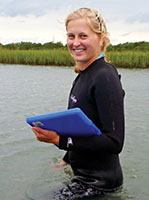2014 Impact Award Winners
Graduate student discoveries are making a difference.
These students are: establishing new ways to understand dangerous blood clots, using the arts to foster public discussion of issues, helping policymakers address coastal challenges, informing federal nutrition standards for school meals programs and creating technologies to improve cancer detection…to name just a few areas in which they are making powerful contributions.
Many different innovative ideas, one common denominator: Graduate students, working in collaboration with their faculty mentors, are conducting this critical research.
The Graduate School's annual Graduate Education Advancement Board Impact Awards recognize graduate students for contributions they are making to our state. These awards are possible thanks to the unwavering support of the Graduate Education Advancement Board (GEAB), whose members truly believe in the importance of graduate education at Carolina.
Sincerely,
Steven W. Matson, Ph.D.
Dean, The Graduate School
Professor of Biology
2014 Impact Awards

"Maria's work is extremely exciting because we anticipate her discovery could translate directly into a treatment to prevent cardiovascular disease," said adviser Alisa Wolberg, Ph.D.
Maria Aleman, Pathology
Fighting Blood Clots More Effectively
Cardiovascular disease and blood clotting disorders are the leading cause of death in North Carolina. Inappropriate blood clot formation within blood vessels, called thrombosis, plays a major role in these acute and often fatal events. Maria Aleman, Ph.D., studied how blood clots form, as well as their composition.
Researchers have thought that red blood cells are passively trapped in clots. Aleman discovered that the retention of red blood cells in clots is actually an active process, mediated by a substance in the blood known as factor XIII (FXIII). Through mouse model studies and the use of human blood samples, she found that if FXIII activation is inhibited or delayed, red blood cell retention in a clot and, therefore, the size of the clot itself are reduced.
Aleman's data suggest inhibition of FXIII may be an effective method for reducing clot size. Her findings establish a new paradigm for understanding how blood clots form and a novel avenue for reducing thrombosis in patients in North Carolina.

"From the time we first encountered Nathaniel at his audition for the program, we were aware that in addition to being a fine young actor, he has an interest in using the theater as a means of public discussion and social change," said adviser Ray Dooley, M.F.A.
Nathaniel Claridad, Dramatic Art
Theater as a Platform for Social Change
From its earliest beginnings, theater has encouraged society to consider the status quo and how it might change. Through the use of theater, master's degree student Nathaniel Claridad developed a number of powerful ways to contribute to North Carolina's public conversation regarding gay marriage.
With the help of partners including UNC-Chapel Hill's Department of Dramatic Art and PlayMakers Repertory Company and Raleigh Little Theatre, Claridad co-produced a staged reading of 8, about the Proposition 8 trials in California. His production coincided with the vote on Amendment One in 2012. He also was co-producer and director for Broadway Twisted, a concert benefiting Broadway Cares/Equity Fights AIDS and the North Carolina AIDS Action Network. He created avenues for theater to intersect with the University's "Water in Our World" theme for 2012-2014.
Each effort included the participation of noted theater professionals and reached a large number of state citizens, as well as local, regional and national media.
Broadway Twisted will be produced again in 2014, under Claridad's co-production and direction. His theater work has the potential to continue to encourage meaningful dialogue in North Carolina about gay marriage and other issues in the LGBTQ community.

"Kari has made seminal contributions to the norovirus field, identifying key sites of virus evolution that not only inform the development of diagnostic assays to identifying new pandemic strains, but also provide rational strategies and targets for improved vaccine and immunotherapeutic design," said adviser Ralph Baric, Ph.D.
Kari Debbink, Microbiology and Immunology
Working Toward a Norovirus Vaccine
Noroviruses are the primary cause of acute gastrointestinal disease in North Carolina, with an estimated 645,000 infections in the state annually. They cause an estimated 21 million infections nationwide.
One particular type, GII.4 noroviruses, accounts for approximately 78 percent of North Carolina outbreaks. Currently, there are no approved norovirus vaccines or therapeutics due to an incomplete understanding of the mechanisms involved with GII.4 norovirus evolution and factors contributing to human protective immunity.
Doctoral student Kari Debbink's research aims to reduce disease caused by noroviruses. GII.4 noroviruses undergo an evolutionary pattern similar to influenza, whereby one predominant circulating strain is replaced by a new emergent strain. She studied non-infectious virus-like particles, which represented epidemic norovirus strains, and performed biological assays that measure activities such as antibody binding and potential neutralization.
By tracking how the GII.4 norovirus evolves, Debbink's work may contribute to the design of successful vaccines and minimize the economic impact that results from lost productivity, decontamination costs and healthcare expenses.

"Paul's dissertation addressed an overarching public health problem in North Carolina by developing a comprehensive understanding of social stressors and coping strategies," said adviser Eugenia Eng, Dr.P.H.
Paul Gilbert, Health Behavior
Increasing Understanding of Stressors, Alcohol Use
Alcohol misuse has long been an important public health concern; however, limited research exists on drinking patterns among immigrant sexual and gender minority Latinos—an especially vulnerable subgroup.
Paul Gilbert, Ph.D., conducted a mixed-methods study, with participants from North Carolina, focused on understanding alcohol use among this population. He described the key social stressors and coping strategies, particularly the role of alcohol use; and tested social support's effectiveness in moderating any relationship between stressors and alcohol use. Gilbert recruited a committee of academics, community members (including gay and transgender identified Latinos), and a representative of a social service organization that serves Latinos to provide key assistance.
Being a sexual minority was found to be a key stressor, as nearly all study participants reported pervasive homophobia within their families and the local Latino community. Being a sexual minority was linked to alcohol use through drinking venues, one of the few locations where participants indicated they could socialize freely and find support. Ethnic discrimination was strongly associated with any drinking and binge drinking.
Gilbert's study findings may inform policies created to integrate and support Latino residents of North Carolina.

Photo courtesy of Rachel Gittman
"The policy implications of her rigorous and inspired research on how to minimize loss of coastal marsh ecosystem services are wide-reaching and highly significant," said co-adviser Charles Peterson, Ph.D.
Rachel Gittman, Environment & Ecology
What Salt Marshes Can Tell State Leaders
Both state and federal policymakers and managers are using doctoral student Rachel Gittman's dissertation research as they address coastal management challenges.
Gittman's interdisciplinary research focuses on the ecology of salt marshes, a vital and increasingly vulnerable coastal ecosystem. As part of her research, she evaluated the effectiveness of different shoreline stabilization approaches in providing the ecosystem services of shoreline protection and habitat for fish and crustaceans. Gittman hypothesized that living shoreline approaches, such as marsh sills (marsh plantings that incorporate a seaward outline of low rocks parallel to the marsh edge), would sustain and enhance ecosystem services provided by salt marshes better than traditional shore stabilization approaches, such as bulkheads.
Gittman's findings indicate that marsh sills can provide better shore protection than bulkheads during storm events, while also enhancing fish habitat. Additionally, based on a nationwide analysis of shoreline data, she found that 14 percent of the U.S. coast has been hardened by some unnatural structure, 66 percent of which has occurred in the Gulf and Southeast regions, where most remaining salt marsh habitat occurs.
Gittman recommends that living shorelines be considered as an ecologically preferable alternative to bulkheads for shore protection, particularly in regions with naturally occurring salt marshes. "Rachel's work is informing coastal homeowners in North Carolina about the best and worst ways to protect their property from storms and sea level rise," said co-adviser John Bruno, Ph.D.

"Since I've known Lindsey, she has consistently expressed an interest in research opportunities that will help identify successful prevention strategies to improve health outcomes of low-income populations in North Carolina," said adviser Pam Silberman, J.D., Dr.P.H.
Lindsey Haynes-Maslow, Health Policy and Management
Eliminating Barriers to Fruit and Vegetable Consumption
Rankings place North Carolina in the top 10 of agricultural producing states in the country-—yet it also ranks in the top 10 for food insecurity.
Doctoral student Lindsey Haynes-Maslow's dissertation research focuses on ways to increase fruit and vegetable consumption in underserved communities in North Carolina. Her analysis relies on data from 13 focus groups she conducted with adults from underserved areas of Buncombe, Durham, Guilford, New Hanover and Orange counties. Participants shared thoughts on their access to fresh fruit and vegetables, current grocery shopping behaviors, perceived barriers to accessing fruit and vegetables in their community and strategies that could improve access in their community.
She found that while proximity to fresh fruits and vegetables is a necessity, it may not be sufficient for improving fruit and vegetable consumption. Understanding the relationship between fruit and vegetable access and consumption is a critical step toward addressing the obesity epidemic in North Carolina, and Haynes-Maslow's research continues to examine this issue.

"She is helping to solve a persistent problem facing local economic development practitioners in the state—how to transform business incentives into a tool for community economic development and not simply as another corporate giveaway," said adviser Nichola Lowe, Ph.D.
Heather Hunt, City & Regional Planning
Developing Effective Business Incentive Policy
The effectiveness of business incentives is hotly debated in North Carolina. Carefully designed and implemented incentive policies have the potential to generate long-lasting investments and community benefits such as good jobs, targeted growth and other important local goals. Given the dollars, potential pitfalls and opportunities at stake, how do practitioners and local governments develop strong and smart policies?
Recent master's degree graduate Heather Hunt, J.D. '02, focused on two ways to help local governments overcome some obstacles to developing incentive policies, including lack of capacity, political pressures, fear of discouraging new business, skepticism and lack of familiarity with the idea. First, she worked directly with local officials in Warren County to develop a targeted and nuanced incentive policy for the county. Second, she conducted broader research on local hiring as a condition of receiving an incentive grant, and clarified local hiring's legality under the state and federal constitution.
Local hiring has been shown to deliver significant and social benefits, including but not limited to reducing local unemployment. Hunt's research may encourage local officials to adopt local hiring, as well as other measures that provide broad economic benefits, as part of their incentive policies.

Photo by Kristen Theuerkauf
"Anna's research is at the frontier of global change science and what it will tell us about North Carolina and the future of its coastal areas," said adviser Brent McKee, Ph.D.
Anna Jalowska, Marine Sciences
Global Change Impacts in the Lower Roanoke River
The Roanoke River is the largest river entering Albemarle-Pamlico Sound. The floodplains and deltaic environments of the Lower Roanoke are valuable ecosystems that provide N.C. coastal communities with recreation, fisheries and storm protection, and play a crucial role in carbon and nutrient cycling. These vulnerable ecosystems are at the nexus between global changes taking place in the watershed and in the coastal ocean.
Doctoral student Anna Jalowska's research investigates sediment distribution and storage in the Roanoke River channel, floodplains and delta, under changes associated with human impacts (like land clearing and river damming), and climate change factors such as accelerated sea-level rise and possible increased intensity of tropical and extratropical storms.
Jalowska has collected and analyzed samples and cores from different parts of the Roanoke River watershed and combined the results with studies of historical and modern maps and images. Her findings indicate that the role of floodplains and delta in processing materials from the watershed has changed dramatically from its natural state dominated by burial to a human-modified state dominated by erosion.
Jalowska's research findings will add vital knowledge to the conservation and restoration efforts in the Lower Roanoke watershed.

"Cynthia's research on the Outer Banks of North Carolina addressed a question for which there is little prior information: can microbial contamination of ocean water from runoff sicken swimmers?" said adviser Steve Wing, Ph.D.
Cynthia Lin, Epidemiology
Protecting the Health of Coastal Swimmers
Stormwater runoff is a major source of coastal water contamination—it can carry many different types of pollution and be discharged directly into the ocean. This can create an occupational health hazard for lifeguards, surf instructors and others who spend time in the ocean.
Cynthia Lin, who recently received her master's degree, sought to better understand the relationship between exposures to microbial water contamination and illness reports from lifeguards and surf instructors in North Carolina. During a 14-week period at the Outer Banks, she collected and analyzed survey data and routine water samples at the time and location of study participant exposure.
Even among young and healthy lifeguards and surf instructors at a location with generally low levels of fecal indicator bacteria, Lin found an increase in illness on days with water exposure compared with days without. She also observed a similar increase in illness related to a five-to-seven day incubation period after water exposure. Her findings did not indicate that the presence or absence of fecal indicator bacteria influenced any symptoms of illness.
Lin's study provides important new knowledge to protect the health of all those who live, work and play along North Carolina's coast.

"Madisa has worked very hard for the sake of public health. She has performed her studies to help us understand the potential effects of children's exposure to this harmful chemical," said adviser Suzanne Fenton, Ph.D.
Madisa Macon, Toxicology
Assessing Risk of a Pervasive Chemical
A manmade chemical, perfluoro-octanoic acid (PFOA), is used in the manufacture of non-stick and stain-resistant products. PFOA can be found in water, food, house dust, fabrics and breast milk, and can be transferred from mother to child in the womb.
Laboratory studies have shown that prenatal PFOA exposure affects mammary gland growth during puberty and lactation, and influences known breast cancer risk factors, but the mechanism behind these effects is unclear. Research by Madisa Macon, Ph.D., used a mouse model to study the mechanisms underlying mammary gland developmental changes in mice. Her results suggest that PFOA altered sex hormone signaling and mammary glands from PFOA-treated mice have two features that have been shown by others to be associated with increased risk for the development of breast cancer.
Published data from Macon's studies have already been used by two agencies in their human health assessment of PFOA toxicity. Her research has the potential to further inform regulatory agencies in North Carolina and beyond in their risk assessment of PFOA.

"The findings from Dr. Martin's project will provide data necessary to inform state government on this critical health care issue with respect to public health policy and allocation of public health funds," said adviser Ceib Phillips, Ph.D.
Jim Martin, Dentistry
Mapping Trends in Oral Health Care for Children
Lack of oral health care for children can contribute to significant school absences, as well as pain, expense and emergency room visits. Orthodontists and pediatric dentists form a distinct and unique part of the oral health care team for children in North Carolina (although some general dentists treat children). However, little information exists on key details concerning this vital workforce.
Master's degree student Jim Martin, D.M.D., assessed the demographics and geographic distribution of practicing general dentists, orthodontists and pediatric dentists in North Carolina during the last 30 years. He related this information to population trends over time and represented those changes using mapping technologies.
Martin obtained the information about dental practitioners through the North Carolina Health Professions Data System, maintained by the Cecil G. Sheps Center for Health Services Research at UNC-Chapel Hill.
Martin's results show, among other findings, that gender and racial/ethnic diversity among the dental workforce has increased and the percentage of the dental workforce in rural areas has decreased. His research will provide valuable insights to practitioners and policymakers in identifying barriers to care in underserved communities.

"Every time Candy publicized her creative activity either in poster sessions or through blogs at the professional theater and technical level, she promoted the North Carolina textile industry," said adviser Judy Adamson.
Candy McClernan, Dramatic Art
Stitching a Bridge Between Costume Design and N.C.'s Economy
Costume designers seeking the perfect fabric frequently find they have to create their own textiles. Master's degree student Candy McClernan's innovation has made this process much easier—and has brought professional regional theaters to a Durham company specializing in fabric replication.
McClernan originally used the company Spoonflower to reproduce a textile chosen from UNC-Chapel Hill's vintage clothing archive and to create theatrical costumes for the University-based PlayMakers Repertory Company. Her process combines hand drawing and digital manipulation, for a design Spoonflower then replicates.
McClernan has given presentations statewide on the topic, bringing vital knowledge to the state's theatrical community. Valuable outreach continues through numerous references in PlayMakers' company blog and other industry blogs.
Her conference presentations have linked North Carolina's historical textile industry to the national and international technical theater community and have brought business to the state's economy.

"Jennifer's work has documented the influential role of supermarkets, grocery stores and other food stores and identifies the need to focus efforts in North Carolina on this major contributor to children's diets," said adviser Barry Popkin, Ph.D.
Jennifer Poti, Nutrition
What Are Key Factors in Childhood Obesity?
An estimated one-third of U.S. children are overweight or obese, and North Carolina has the fifth highest prevalence of childhood obesity within the 50 states. Doctoral student Jennifer Poti's research looks comprehensively at factors that may contribute to poor dietary quality and obesity among children.
Poti designed a study using data on U.S. children's eating habits, collected from 1977 to 2006. She found that increases in total calorie intake among U.S. children in the years examined were driven by major increases in eating away from home. Her study established fast food as the largest contributor to food prepared away from home for all age groups of children, but determined that two-thirds of children's calorie intake comes from supermarkets and grocery stores.
Her research determined that an unhealthy Western dietary pattern from grocery stores and schools was more strongly associated with obesity and poor dietary quality than was fast food consumption.
Poti identified specific foods and locations to target for improvement, and her study findings have been used by the U.S. Department of Agriculture in developing revised federal nutrition standards for the school meals programs.

"Brad's dissertation connects the Reconstruction-era tumult and violence in North Carolina to the larger and enduring national struggle over the meaning of democracy and equality after the abolition of slavery," said adviser Fitzhugh Brundage, Ph.D.
Bradley Proctor, History
Klan Violence in the Carolinas During Reconstruction
After the American Civil War destroyed racial slavery, the United States South was faced with reconstructing its political, economic and social systems. Dissertation research by Bradley Proctor, Ph.D., asserts that though some Southerners tried to create a more equitable world, the white men who joined the Ku Klux Klan wanted to create a new racial hierarchy and joined a clandestine, regional organization committed to violence to do so.
Proctor explored violence committed by members of the Ku Klux Klan in the Carolinas during the Reconstruction years of 1868 to 1872. He analyzed not just what prompted them to commit violence but also the terror experienced by its individual survivors and the lasting effects of that violence.
Proctor used evidence from testimonies in federal investigations into the Klan, trials of suspected Klansmen, private documents by men who participated in the Klan, letters from contemporary observers and narrative accounts by people who were targeted by Klansmen for violence.
The violence Klan members committed against hundreds of victims in the Carolinas had lasting political, economic and social consequences, Proctor states, working to prefigure the system of racial oppression that would eventually come to structure the American South: Jim Crow segregation.

"Agostina has made new findings that will be critical to preventing adverse health consequences of obesity or weight gain in the citizens of North Carolina and beyond," said adviser P. Kay Lund, Ph.D.
Agostina Santoro, Cell & Molecular Physiology
Improving Early Colorectal Cancer Detection
Sixty-six percent of North Carolina's population is overweight or obese. Obesity results in elevated levels of plasma insulin, which activates the insulin receptor (IR) or the insulin-like growth factor 1 receptor (IGF1R)—this activation favors cell growth and survival, and may increase the risk for colorectal cancer. Elevated plasma insulin also can inhibit a form of cell death that helps prevent tumors, known as apoptosis.
In an effort to better understand the roles IR and IGF1R play in colorectal cancer, doctoral student Agostina Santoro first examined normal colon biopsies of patients with elevated plasma insulin and pre-cancerous polyps. She found that these individuals exhibited reduced cell death and low IGF1R expression, as well as an increase in the relative levels of an IR variant that has been linked to cancer. She then conducted mouse model studies indicating that obesity reduced death of colon cells with cancerous potential, and loss of IR attenuated this effect back to levels observed in lean mice.
Santoro's research suggests that obesity and IR may contribute to colorectal cancer risk by making colon cells resistant to apoptosis. This will help develop therapies that improve early detection and prevention strategies for individuals at higher colorectal cancer risk.

Photo courtesy of Julianne Schmidt
"Local high schools, as well as USA Football, are using the results of Julianne's research to teach both players and coaches safer playing techniques. The results are very likely to lead to a reduction of concussions, and will be a game changer," said adviser Kevin Guskiewicz, Ph.D.
Julianne Schmidt, Human Movement Science
Reducing Football-Related Concussions
What modifiable factors could lessen the severity of head impacts that occur during sports? Julianne Schmidt, Ph.D., ATC, studied whether high school and collegiate football players with stronger, larger and stiffer neck musculature had reduced odds of sustaining higher magnitude head impacts relative to players with weaker, smaller and less stiff neck musculature.
Her study involved 49 N.C. high school and college football players, for whom she analyzed measurements of neck strength, muscle size, stiffness and reflexes before the fall 2012 football season. Head-impact severity, frequency and location were captured using the Head Impact Telemetry System during practices and games.
Schmidt's findings indicate that linemen with stronger neck musculature are 1.75 times more likely to sustain moderate head impacts compared to weaker linemen. Players with greater neck stiffness are less likely to sustain both moderate and severe head impacts, rather than mild ones.
Her research indicates that neuromuscular training aimed at improving the dynamic response of the neck musculature may be a more effective approach than strength training in reducing head impact severity among football athletes.

"I fully expect that Jing's research will lead to a new medical imaging device that will benefit patients worldwide," said adviser Otto Zhou, Ph.D.
Jing Shan, Physics and Astronomy
New Imaging System: Hope for Lung Cancer Detection
North Carolina is among the states with the highest lung and bronchus cancer incidence and resulting death rate. Factors in the high death rate include limitations in detecting and treating cancer at its early stage. Doctoral student Jing Shan—working with Otto Zhou, Ph.D., and Jianping Lu, Ph.D., in physics, and Yueh Z. Lee, M.D., Ph.D., in radiology—has developed a next-generation imaging system to help diagnose lung cancer earlier.
Currently, the "gold standard" for imaging lung lesions is chest computed tomography (CT). Chest tomosynthesis, an emerging diagnostic X-ray imaging technique, has comparable lung cancer detection sensitivity to CT but with a much lower radiation dose and cost. Shan's research project produced a next generation stationary chest tomosynthesis system using carbon nanotube source array. This system can significantly improve image quality and reveal hidden subtle lung tumors.
A pilot clinical trial using this prototype scanner is scheduled for later in 2014. Shan's newly developed system may help doctors diagnose lung cancer at its early stage, when it is easier and less expensive to treat, helping to save lives and reduce health costs.

"Paul is a brilliant scientist who is well poised to make an impact in biomedical research with technologies that may benefit the population of North Carolina, as well as the world," said adviser Paul Dayton, Ph.D.
Paul Sheeran, Biomedical Engineering
Bringing More Effective Cancer Detection to Rural Areas
Cancer was the leading cause of death between 2007 and 2011 in North Carolina, with significantly increased mortality rates in rural counties. This may be partly due to a delay in diagnosis and treatment brought by limited access to hospitals with advanced tools for imaging and therapy.
Ultrasound imaging is relatively inexpensive and portable—providing important advantages for rural regions. However, typical ultrasound contrast agents are not able to penetrate the tissue of tumors as effectively as contrast agents in magnetic resonance imaging (MRI) and computed tomography (CT). Doctoral student Paul Sheeran's research focuses on developing new, and more highly sensitive, contrast particles that can overcome these limitations.
Specifically, Sheeran has worked to develop nanoparticles that can be manipulated by ultrasound energy to image and treat highly vascularized cancers. Much cancer research in the past decade has focused on exploiting how fast-growing cancers recruit new blood networks rapidly—leaving gaps in blood vessel walls that don't exist in healthy tissue. By delivering carefully designed particles to the cancerous tissue through these "leaky" vessels, Sheeran hopes tumors can be imaged and treated more effectively.

"Ultimately, what teens learn from the timely feedback they get on their cell phones may help reduce the number of STIs and teen pregnancies in the state," said adviser Jane Brown, Ph.D.
Jessica Willoughby, Journalism and Mass Communication
Increasing Teen Access to Health Knowledge
North Carolina leaders have announced a goal to reduce the state's teen pregnancy rate by 30 percent by 2020. Knowledge is an important component of good decision making and can aid in pregnancy prevention. In 2009, the Adolescent Pregnancy Prevention Campaign of North Carolina launched a service allowing teens to text sexual health questions to a trained health educator, who would then provide a personalized response.
Titled BrdsNBz, the message service has received honors for its innovative approach. Jessica Willoughby, Ph.D., developed a three-month-long social marketing campaign to increase awareness of the service; she conducted the campaign for six public middle and high schools in Stokes and Cabarrus counties. She then analyzed the results.
Her project had an immediate impact in North Carolina by informing more than 2,000 young people about an important health resource and by providing the statewide agency that manages BrdsNBz with strategies to enhance the effectiveness of this valuable service.

"Dominica's innovations have significant commercialization potential given the increasing demands that mobile electronics are placing on safety," said adviser Joseph DeSimone, Ph.D.
Dominica Hiu Ching Wong, Chemistry
Safer and More Efficient Electric Vehicles
North Carolina is expected to become the seventh most populous state in the nation by 2030, increasing the need to find ways to decrease sources of airborne pollution. Electric vehicles represent one solution and state incentives support their use—yet safety concerns surrounding lithium-ion batteries in electric vehicles may discourage some residents from making the switch.
Doctoral student Dominica Hiu Ching Wong has developed alternative electrolytes that can dramatically improve the safety of performance of lithium-ion batteries. By using a unique class of polymers, Wong designed electrolytes that have a high thermal and chemical stability, low toxicity and low flammability. In addition, the polymers she used are compatible with existing battery electrodes and assembly protocols. These materials are significantly safer than the spontaneously combustible carbonate-based electrolytes currently found in lithium-ion batteries.
The new electrolytes can accelerate the development of safer and more efficient electric vehicles. They have the potential to lead to new jobs, enhance energy security, lessen environmental pollution and improve health for North Carolina residents.
